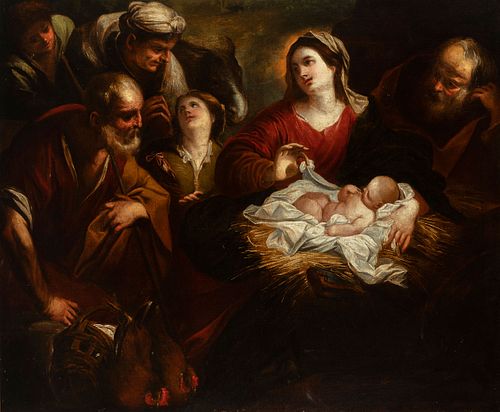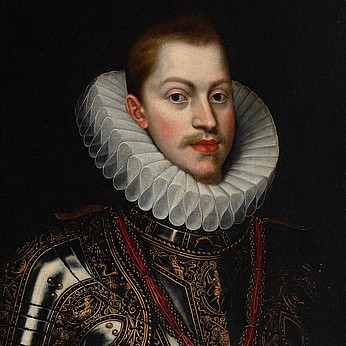Attributed to VALERIO CASTELLO (Genoa, 1624-1659). "Adoration of the shepherds". Oil on canvas. Relined.
Lot 76
About Seller
Setdart Auction House
Carrer Aragó 346
Barcelona
Spain
Setdart Subastas was born in 2004 and is currently the first online art auction in Spain with solidity, prestige and reliability guaranteed by our more than 60,000 users. Setdart has a young, dynamic and enterprising team ready to successfully manage the purchase and sale of art works through custom...Read more
Estimate:
EUR€18,000 - EUR€20,000
$18,750 - $20,833.33
Absentee vs Live bid
Two ways to bid:
- Leave a max absentee bid and the platform will bid on your behalf up to your maximum bid during the live auction.
- Bid live during the auction and your bids will be submitted real-time to the auctioneer.
Bid Increments
| Price | Bid Increment |
|---|---|
| EUR€0 | EUR€10 |
| EUR€200 | EUR€25 |
| EUR€500 | EUR€50 |
| EUR€1,000 | EUR€100 |
| EUR€3,000 | EUR€200 |
| EUR€5,000 | EUR€500 |
| EUR€10,000 | EUR€1,000 |
| EUR€20,000 | EUR€2,000 |
| EUR€50,000 | EUR€5,000 |
About Auction
By Setdart Auction House
Nov 24, 2021
Set Reminder
2021-11-24 09:00:00
2021-11-24 09:00:00
America/New_York
Bidsquare
Bidsquare : Old Masters, Day 1
https://www.bidsquare.com/auctions/setdart-auction-house/old-masters-day-1-7873
Setdart Auction House sofia@setdart.com
Setdart Auction House sofia@setdart.com
- Lot Description
Attributed to VALERIO CASTELLO (Genoa, 1624-1659). "Adoration of the shepherds". Oil on canvas. Relined. It has French frame, ca. 1820. Measurements: 125 x 150 cm; 139 x 165 cm (frame). This canvas represents a classic theme in the History of Art, that of the shepherds adoring the newborn baby Jesus in the portal of Bethlehem. It is a scene that lends itself to be interpreted as a large composition with several characters, worked in a costumbrista key, so it was very much to the taste of Baroque painters, who sought above all a natural and close art, which moved the mood of the faithful and made them feel close to what was represented on the canvas, to the sacred story. In this case, the luminosity of the cloth on which Jesus stands stands out, which harmonizes with the pearly white of the Virgin's skin. Next to the Child, located on the right side of the composition, are his parents; Mary and Joseph and to the left several shepherds who have been portrayed in successive planes. The representation of this biblical theme reached great popularity, especially during the reform, since it is a scene in which a disadvantaged family is presented, since no one wanted to shelter it. However, despite this, the star has guided the three wise men and several shepherds on a pilgrimage to the birth of Jesus, thus demonstrating that he is the Messiah, a king for all social classes. This passage is collected in the Gospel according to Luke (2:15:20) which narrates "And it came to pass, when the angels departed from them into heaven, that the shepherds said one to another, Let us go over therefore unto Bethlehem, and see this thing that is come to pass, which the Lord hath shewed unto us. So they came with haste and found Mary and Joseph, and the babe lying in the manger. And when they saw him, they made known what had been told them concerning the child. And all who heard it marveled at what the shepherds told them. But Mary kept all these things, pondering them in her heart. And the shepherds returned glorifying and praising God for all the things they had heard and seen, as they had been told." Valerio Castello was the youngest son of Bernardo Castello, who died when Valerio was six years old. It was then that Valerio and his siblings came under the protection of Torquato's family. Because of Castello's interest and skill with drawing, Torquato's family urged him to begin his artistic career. It was then that he began to learn with the master Domenico Fiasella. He later studied with Giovanni Andrea de 'Ferrari and finally completed his apprenticeship with trips to Parma and Milan. His work achieved great recognition thanks to his mastery in painting war themes. His work shows certain aesthetic inheritances of Tintoretto and Veronese, although he also professed great admiration for Van Dyck, whose work he had been able to contemplate in Genoa.
- Shipping Info
-
In-house shipping available. Please inquire at admin@setdart.com.
-
- Buyer's Premium



 EUR
EUR CAD
CAD AUD
AUD GBP
GBP MXN
MXN HKD
HKD CNY
CNY MYR
MYR SEK
SEK SGD
SGD CHF
CHF THB
THB

















